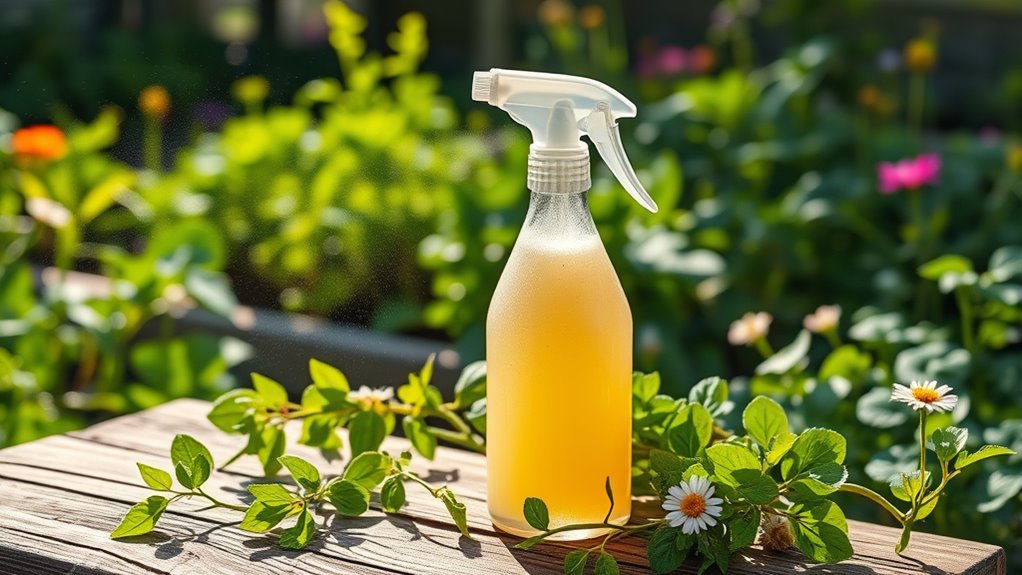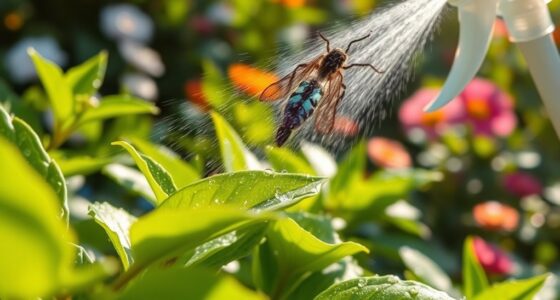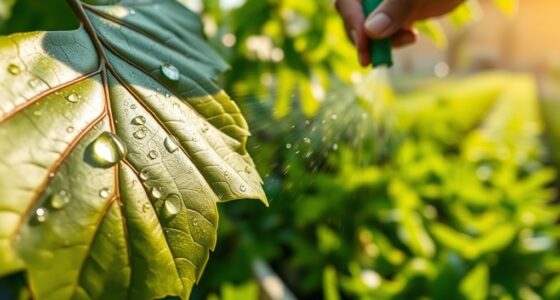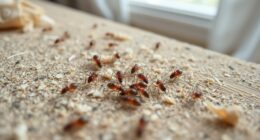To make a DIY natural insecticide, mix 1-2 teaspoons of gentle, biodegradable soap with a quart of water, shake well, and spray thoroughly on affected plants, focusing on leaf undersides and pest hideouts. Use it weekly or after rain to keep pests at bay. Be cautious to avoid leaf burn and beneficial insects. Keep exploring to discover more tips for effective, eco-friendly pest control that benefits your garden’s health.
Key Takeaways
- Use gentle, biodegradable soap like castile soap, mixing 1-2 teaspoons per quart of water for an effective DIY insecticide.
- Shake the solution well and spray thoroughly on pests’ hiding spots, including undersides of leaves.
- Apply during cooler parts of the day and repeat every 5-7 days or after rain for sustained control.
- Test on a small plant area first to prevent leaf burn, especially in hot weather or with concentrated solutions.
- Incorporate soap sprays into an integrated pest management plan to promote eco-friendly and sustainable gardening.
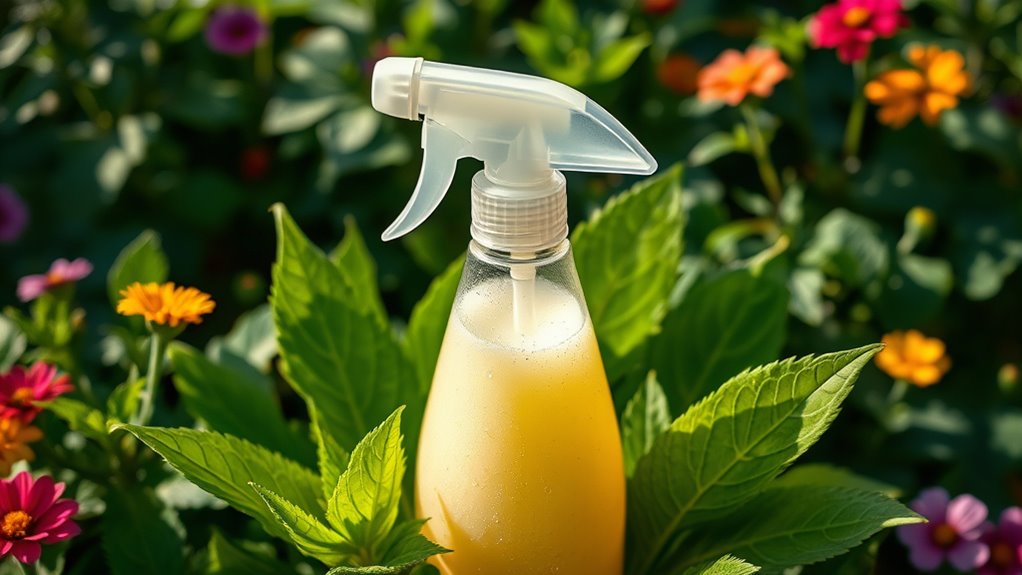
Soap sprays are a versatile and effective solution for cleaning a variety of surfaces around your home or garden. When it comes to pest control, they’re especially valuable because they offer an eco-friendly alternative to chemical pesticides. If you’re into organic gardening, soap sprays become your go-to tool for managing pests without compromising the health of your plants or the environment. They work by suffocating insects like aphids, spider mites, and whiteflies, disrupting their cell membranes, and ultimately killing them. This method is safe for beneficial insects and pollinators when applied carefully, making it ideal for those committed to organic gardening principles.
Soap sprays are eco-friendly solutions for pest control in organic gardening.
To create a basic soap spray, you don’t need many ingredients—just a gentle liquid soap or castile soap and water. You’ll want to mix about one to two teaspoons of soap per quart of water. The key is to use a soap that’s biodegradable and free from added fragrances, dyes, or harsh chemicals, which could harm your plants. Once mixed, pour the solution into a spray bottle and shake well. Before applying it broadly, test it on a small section of your plants to ensure they won’t be irritated. When spraying, target the undersides of leaves and other areas where pests tend to hide. Repeat applications every 5 to 7 days, or after rain, until you notice a significant decrease in pest activity.
Soap sprays are particularly popular in organic gardening because they align with natural pest management strategies. They don’t leave toxic residues and are safe for children, pets, and beneficial insects like bees and ladybugs. This makes them a sustainable choice for maintaining a healthy garden ecosystem. Additionally, soap sprays are cost-effective; you can make large batches at home, saving money compared to commercial pesticide options. Regular use prevents pest populations from spiraling out of control, and since soap sprays are non-selective, they can help eliminate various pests without harming your plants or the surrounding environment.
Furthermore, understanding state-specific tax laws can be helpful when planning your gardening budget and pest control expenses, especially if you are purchasing commercial products.
However, it’s important to use soap sprays judiciously. Over-application or using a harsh soap can cause leaf burn or other damage. Always follow the recommended dilution and avoid spraying during the hottest part of the day to prevent leaf scorching. When used properly, soap sprays become a powerful tool that supports your goal of organic gardening—keeping pests at bay while safeguarding the health of your garden’s ecosystem. With a little practice, you’ll find that soap sprays are an essential, natural, and effective part of your pest control arsenal.
Frequently Asked Questions
Can Soap Sprays Harm Beneficial Insects in My Garden?
You might wonder if soap sprays harm beneficial insects in your garden. Soap spray selectivity generally favors pest insects while sparing beneficial ones, especially when used correctly. To guarantee beneficial insect safety, apply the spray during early morning or late evening when beneficial insects are less active. Avoid overuse and target only affected areas. This careful approach helps protect your garden’s helpful insects while controlling pests effectively.
How Often Should I Apply Soap Spray for Optimal Results?
If you want to conquer pests like a garden warrior, you need perfect application frequency. Apply soap spray every 7 to 10 days to keep pests at bay and prevent resurgence. Too often, and you risk harming beneficial insects; too seldom, and pests will bounce back stronger. Stay consistent, monitor your plants, and you’ll maintain a healthy, pest-free garden without overdoing it.
Are Homemade Soap Sprays Safe for Edible Plants?
Homemade soap sprays can be safe for edible plants if you prioritize plant safety and use the right soap concentration. You should choose gentle, biodegradable soaps and dilute them properly to avoid damage. Always test the spray on a small area first, wait 24 hours, and observe for any adverse effects. Using the correct soap concentration helps protect your plants while effectively controlling pests.
What Are the Best Ingredients for a Homemade Natural Insecticide?
Imagine your garden as a thriving fortress, where the best ingredients become your secret defenders. You want to use plant-based oils like neem or neem oil, which act as shields against pests. Botanical extracts such as garlic or chili pepper add fiery resistance. These natural elements work together, offering an eco-friendly, effective solution that respects your garden’s delicate balance, keeping it healthy and vibrant without harmful chemicals.
How Do I Store Leftover Soap Spray Solution Safely?
To guarantee storage safety and preserve your leftover soap spray solution, transfer it to a clean, airtight container. Label it clearly with the date and ingredients for easy identification. Keep the container in a cool, shaded spot away from children and pets to prevent accidental ingestion or contact. Regularly check the solution for any signs of spoilage or separation, and discard it if it looks or smells off to maintain safety and effectiveness.
Conclusion
Now that you know how to make soap sprays, you’re like a gardener wielding a gentle yet effective shield against pests. These DIY solutions are simple to create and kind to your plants and the environment—just like a soft breeze on a warm day. With a little effort, you can keep your garden healthy and thriving, turning it into a lush, pest-free paradise. So go ahead, spray away and enjoy your flourishing, vibrant garden!
